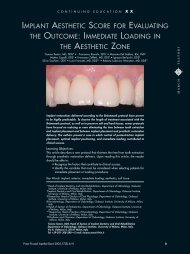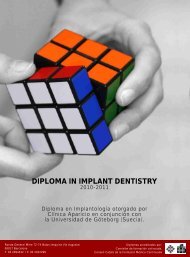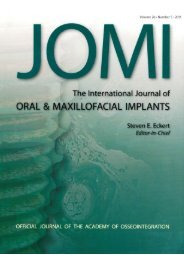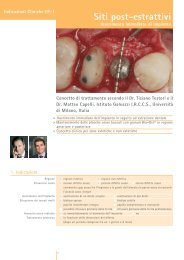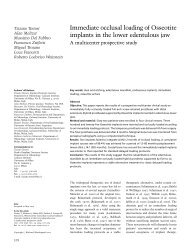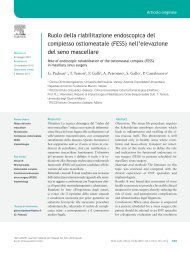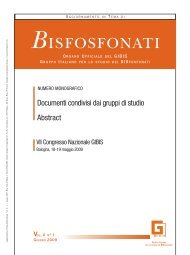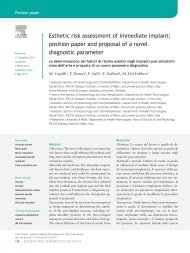Maxillary sinus vascular anatomy and its relation to sinus lift surgery
Maxillary sinus vascular anatomy and its relation to sinus lift surgery
Maxillary sinus vascular anatomy and its relation to sinus lift surgery
You also want an ePaper? Increase the reach of your titles
YUMPU automatically turns print PDFs into web optimized ePapers that Google loves.
Rosano et al Haemorrhage risk during <strong>sinus</strong> <strong>surgery</strong><br />
<strong>sinus</strong>al or sub-periosteal) in the maxillary tuberosity<br />
area.<br />
The vertical distance from the lowest point of<br />
the vessel, corresponding <strong>to</strong> the first molar area,<br />
<strong>to</strong> the alveolar crest averaged 11.25 2.99 (SD)<br />
mm (range between 7.2 <strong>and</strong> 17.7 mm).<br />
The residual ridge height ranged from 0.7 <strong>to</strong><br />
5.1 mm (mean height 3.60 1.28 mm). A slight<br />
positive cor<strong>relation</strong> between such a distance <strong>and</strong><br />
the ridge height was observed (r ¼ 0.38). When<br />
considering a threshold of 3 mm for the residual<br />
ridge height, the AAA-<strong>to</strong>-alveolar crest distance<br />
averaged 9.33 2.41 (n ¼ 39) <strong>and</strong> 12.45 2.71<br />
(n ¼ 55) for cases with ridge height o3mm <strong>and</strong><br />
3 mm, respectively.<br />
Discussion<br />
The anas<strong>to</strong>mosis between PSAA <strong>and</strong> IOA provides<br />
blood supply <strong>to</strong> the <strong>sinus</strong> membrane, <strong>to</strong> the<br />
periosteal tissues, <strong>and</strong> especially, <strong>to</strong> the anterolateral<br />
wall of the <strong>sinus</strong> (Solar et al. 1999; Rosano<br />
et al. 2009).<br />
The scientific literature reports that this vessel<br />
is located at an average distance of 19 mm (Solar<br />
et al. 1999; Traxler et al. 1999), 16.4 mm (Elian<br />
et al. 2005) <strong>and</strong> 16.9 mm (Mardinger et al. 2007)<br />
from the alveolar crest of the posterior maxilla.<br />
Nevertheless, such data can be misleading<br />
because the height of the residual bony ridge,<br />
the maxillary atrophy class <strong>and</strong> the presence of<br />
Fig. 3. Internal view of the maxillary <strong>sinus</strong>: the arrow A shows the alveolar antral artery, the endosseous branch of the<br />
posterior superior alveolar artery (PSAA), partially encased in the lateral <strong>sinus</strong> wall, while the arrow B shows the infraorbital<br />
artery deriving from the maxillary artery <strong>and</strong> forming a <strong>vascular</strong> arcade with the PSAA.<br />
teeth play a relevant role in determining the<br />
location of the vessel.<br />
In the present study, the average distance of the<br />
AAA from the alveolar ridge in atrophic maxillae<br />
of Cawood & Howell class V <strong>and</strong> VI was<br />
11.25 mm. For the most atrophic cases, in which<br />
the ridge height is inferior <strong>to</strong> 3 mm, such a<br />
distance was significantly lower with respect <strong>to</strong><br />
lesser atrophic cases. This would confirm that<br />
the more resorbed the bone crest, the higher the<br />
risk of violation of such a vessel during <strong>sinus</strong><br />
augmentation procedure.<br />
These results are substantially in agreement<br />
with the study by Mardinger et al. (2007), which<br />
found that this vessel was located at a mean<br />
distance of 10.9 mm from the crest in classes<br />
D, E (Lekholm & Zarb 1985) <strong>and</strong> at a distance<br />
greaterthan15mminclassesA,B<strong>and</strong>C.<br />
Differences concerning the mean distance from<br />
the vessel <strong>to</strong> the crest, with the studies by Solar<br />
et al. (1999), Traxler et al. (1999) <strong>and</strong> Elian et al.<br />
(2005) are probably due <strong>to</strong> the more strict inclusion<br />
criteria considered in the present study,<br />
where only highly atrophic ridges have been<br />
examined.<br />
Moreover, because a well-distinguished bony<br />
wall between the intra-osseous maxillary anas<strong>to</strong>mosis<br />
<strong>and</strong> the maxillary <strong>sinus</strong> has never been<br />
found by ana<strong>to</strong>mic dissection (Fig. 1), it could be<br />
speculated that the lowest border of such a vessel<br />
Fig. 4. Computed <strong>to</strong>mography scan transversal views of the anterior lateral wall of a <strong>sinus</strong> where it is possible <strong>to</strong> evidence the course of the alveolar antral artery from the infraorbital artery (1)<br />
<strong>to</strong> the posterior superior alveolar artery (2): completely intra-osseous at <strong>its</strong> extremities, between the Schneiderian membrane <strong>and</strong> the bony wall in the <strong>sinus</strong> antros<strong>to</strong>my area, sub-periosteal in<br />
the maxillary tuberosity area.<br />
c 2010 John Wiley & Sons A/S<br />
3 | Clin. Oral Impl. Res. 10.1111/j.1600-0501.2010.02045.x



